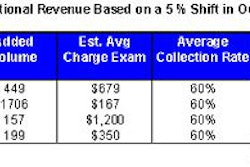This is the second in a series of AuntMinnie articles that follows Bayonne Medical Center, a small community hospital in Bayonne, NJ, as it plans and implements an enterprise-wide PACS network.
Moving ahead systematically with its PACS implementation plan, Bayonne Medical Center recently set up a series of vendor demonstrations. During half-day sessions, each of five firms contending for the BMC PACS project gave overview presentations on their companies and demonstrated their products' capabilities.
BMC's PACS planning team scored each vendor on overall criteria such as system functionality, workstation tools, flexibility, and ease of use, said Patrick Giordano, executive director of imaging and vascular services at BMC, a 276-bed hospital in Bayonne, NJ, that performs 90,000 procedures per year.
With the aid of questions provided by BMC's consulting firm, SG&A Consulting of Arlington, TX, BMC representatives queried each vendor on its ability to handle a number of scenarios, such as display of asymmetric screen splits and how the system organizes security levels.
The group paid particular attention to the systems integration capabilities of the competing vendors, Giordano said.
"That's what makes it so exciting, the ability to virtually go filmless and paperless," he said. "Without that capability, you're still prone to analog processes. We're going to convert to digital image management in a way that's enriching for all of our users, including my internal staff and our external physician users."
For example, BMC desires a PACS that can provide document scanning, strong integration with other information systems and voice-recognition software, and support for cardiology images, Giordano said. In the vendor demonstrations, BMC discovered that some firms had strong image-distribution capabilities, but were relatively weak in providing interconnectivity. For some companies, the opposite was the case.
Also high on the BMC priority list: speed.
"When I click on an image, if I have to drum my fingers more than three times it's a failure," he said. "My physicians don't have time to click and wait."
While BMC won't hold vendors to such a standard for Web-based image distribution, a fast-performing system will be a requirement to support in-house access by radiologists and referring physicians, he said.
BMC is also paying close attention to each PACS company’s track record in the marketplace, and its prospects for long-term stability. Given the long-term nature of a PACS commitment, it's important to select a vendor that will be around in the future with a product that's not in danger of early obsolescence, Giordano said.
In this era of the Health Insurance Portability and Accountability Act (HIPAA), it's also crucial to keep security in mind. To that end, BMC wanted to see each vendor’s ability to perform audit trails, among other security mechanisms, Giordano said. BMC is also interested in flat-panel displays, which offer the promise of higher luminescence.
A short list
Based on the demonstrations, BMC and SG&A Consulting have trimmed the prospects to a short list of three vendors. A request for quotation (RFQ) will be issued this month to the three remaining firms. When the RFQs are received, that list may even be shortened further, Giordano said.
"Maybe there's such a price difference that we could narrow it down," he said. "And we might be very happy with one of the three."
After the RFQ process is completed, BMC representatives plan to conduct site visits. In addition, the remaining vendors will be invited back to perform full-day demonstrations, which will be made to BMC's information systems steering committee and other physician stakeholders, Giordano said. BMC hopes to make its final vendor selection by July, with full implementation targeted for autumn.
By Erik L. RidleyAuntMinnie.com staff writer
June 24, 2002
Next: RFQs, site visits
Related Reading
From planning to PACS: A community hospital's journey, April 11, 2002
Copyright © 2002 AuntMinnie.com



















